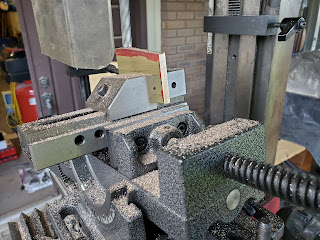I have some treasured pens, both from when I made some, and also from some family members and dear friends. They've sat in a pile on my desk for some time. As I started reclaiming my desk space, I had to shift the pens from a pile onto a display rack of some sort.
I ordered some acrylic sheets and a flat bar of brass. The acrylic sheet was 1/4" thick, and 12" x 24". I marked off some dimensions that looked good to me (yes, I put a story board on the acrylic protective layer). With a sheet 24" long, I could theoretically put 23 holes across... but the sheet wasn't quite 24" long - it was 23 3/4" long. So, my design went from 23 holes across, to 22 holes across (oh, bummer).
I drilled three rows of holes through the acrylic every 1" using a 3/4" forstner bit. That was 66 holes., if you do the math.
While there, I also drilled clearance holes through the same acrylic sheet to attach brass flat stock for shelf risers (separating a bottom shelf from a top shelf - and now that I have mentioned top shelf, I feel the need to go watch some hockey). Once the drilling was complete, I fed the sheets through the table saw.
I absolutely took my time on this - and you should, too. The last time I fed plastic through the table saw, it grabbed to the blade and was hurled up and back at me so quickly that it could have been fatal if not for the eye protection. TAKE YOUR TIME, and use push sticks in constant contact at all times!
Three rows of holes equates to two shelves. As you look at the above picture, you'll see one row of holes was cut lengthwise. The bottom shelf on each one sits farther away from the wall with a full hole, while the top shelf (again, I need more hockey) is only a half hole. This allows a pen to lean against the top shelf (oh, puck!), and be easily removable when I want to use one.
With the holes through the bottom, I needed to glue the last thin strips onto the bottom of the bottom so that pens didn't fall through (it was a bit of a duh moment, and I didn't want to order a new sheet - I had two 3/4" strips left over from slicing the shelves out of the acrylic, and that would be perfect).
I thought I'd use a heat gun before anything else to "clean up" the saw and drill edges - to get them a little more clear and a little more professional. You know, the usual thoughts about burning plastics when thermoforming such as being quick, and don't get it too hot or the acrylic might change color (e.g. it could burn and become more opaque if you go too long). I ran some off cuts through the process.
While it worked a little bit, it did not get the edges very clear. I had to fully remove the wrap, or the edge would bubble up and get some discoloration. Anyway, with the little result for a lot of effort and chancing really hosing it up, I opted against heat gunning the pieces.
So I could glue the thin bottom strips to the bottom shelf. The glue I used was super glue - cyanoacrylate - notice the "acryl" in both of the technical terms. Be careful as you apply it to acrylic - it quickly adheres and if you get it in the wrong place.... well, it won't clean up.
Earlier, when story boarding, I also marked the brass flat bar for saw cuts. I fed these through the bandsaw.
I want to see how this is going to look. Time for a quick mock up.
While it looks good from here, those are still bandsaw cuts. They are rough, and not something I'd be willing to display yet, let alone be a back drop for other displayed items. I need to clean it up. Enter the milling machine.
Yeah, I had to see it set up. It was time to sand in order to remove any mill scale and apprentice marks (e.g. when you drop it and ding it up).
While here, I took the time to sand the rough edges of acrylic, and I hit them with a torch. Remember when my impatience got to me? Sanding the acrylic saw/drill surfaces to 2000 grit and then hitting with a torch actually improved those edges.
Slap some pens on that just to see....
The shelves look fantastic, and have definitely cleared up my desk surface a bit. I am sending one of the two shelves that was built to the person who makes pens as his hobby. I might as well share the joy.




















No comments:
Post a Comment